Question Response Analysis
Below we set out the questions and analyse the responses received on an individual question basis.
Ministerial Directions
Question 1
Do you agree or disagree with the proposed road characteristics that would allow local authorities to consider an exemption order from the pavement parking prohibition?
The total number answering this question was 623 with 3 not answering.
118 respondents (19%) answered agree for this question. 505 respondents (81%) answered disagree, with 3 not giving a response (0%).
65% of the 20 local authorities who answered this question answered agree while 35% answered disagree.
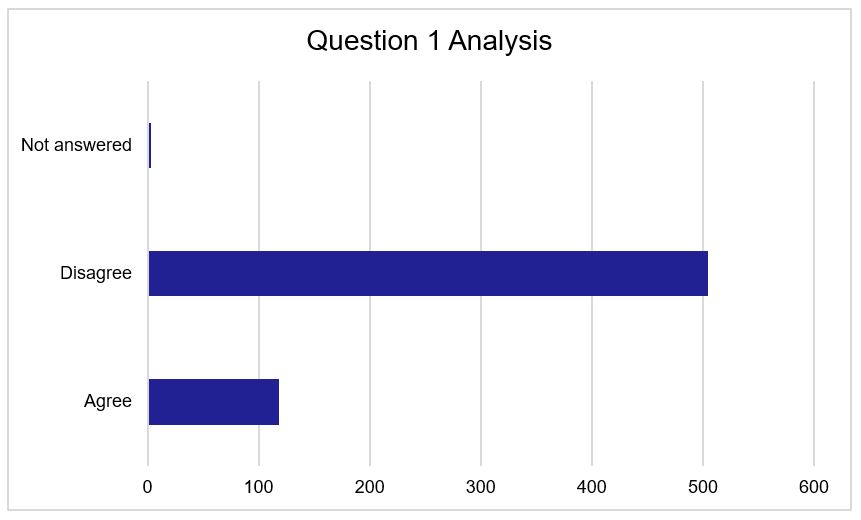
Question 1 Analysis
Of the 594 comments received for question 1, 97 were from respondents who answered agree to question 1 and 495 from those who answered disagree. 2 respondents who left a comment did not answer question 1.
Example comments relating to question 1 are included below:
“Agree” response comments
Individual comments
“I live in a street which is a dead end. There is no through traffic. The street was built at a time when very few people had a motor vehicle. All residents use the pavement to park. This allows other cars, police, service and emergency vehicles to access the street. Due to the width of the street if householders parked on the road then other vehicles could not pass. The street has many elderly residents who need to park their car outside of their house.”
Local authority comments
“There are a number of streets in our Council area, with limited alternative parking availability within a reasonable distance, where footpath parking should be permitted to ensure that emergency vehicles and other vehicular traffic is not obstructed.”
Organisation comments
“We believe these are suitable descriptions, while we would also include larger refuse vehicles within the scope of point b.
More widely, we believe this is going to put a lot of pressure on local authorities who will be required to do street-by-street assessments rapidly once the law is changed. We would encourage a degree of leniency and common sense before full enforcement takes place.”
“Disagree” response comments
Individual comments
“Pedestrians are at the top of the transport hierarchy and so their needs must be considered first.
Point A is acceptable as suitable space is provided for pedestrians with vehicles parked on the footway. I would expect there to be some provision to secure the pedestrian space, such as a secondary kerb.
Point B is unacceptable as it prioritises the storage of private vehicles over the free movement of pedestrians. If there is insufficient space to safely park vehicles on the carriageway while maintaining access for emergency vehicles and preserving the footway, then parking should be prohibited. If Point B was enacted, it will explicitly force pedestrians, and wheelchair and mobility scooter users onto the carriageway. This cannot be considered safe.”
Local authority comments
“We do not believe characteristic (b) is well worded. If we are going to use these to justify Eos (Exemption Orders) then this wording must be clear for all.
There will be situations where there is insufficient road width or pavement width. There will need to be exceptional circumstances taken into account. An example is Raven Road, Greenock where emergency access can be provided however pedestrians are unable to use the pavement.”
Organisation comments
“Neither of the proposed grounds for exemption are acceptable: no streets should be exempt from the ban on pavement parking. This is for the following reasons:
1) as a matter of principle, “pavements are for people”, not vehicles. The interests of pedestrians, and especially disabled pedestrians, should be paramount.
2) pavement parking damages footways which are not generally designed to carry the weight of a motor vehicle.
3) restrictions on parking are one of the main tools at the disposal of a local authority to achieve environmental and social goals such as the targets for reducing car travel by 2030 (20% nationally, 30% in Edinburgh).
4) any exemption will leave a council powerless to intervene should a pavement be obstructed, even if it appears that the pavement is wide enough to accommodate pavement parking.
5) if a street is too narrow for a fire engine or other emergency vehicle to pass, then parking should be banned altogether.
6) the implementation of exemptions would involve a range of legal orders, installation of signage etc. which would be an unwelcome additional burden on council responsibilities and budgets, and also add to pavement clutter.
7) a ’zero-exemption’ policy would permit quicker implementation of the ban.
Councils should instead focus enforcement resources where they are needed most, while retaining, for all streets, the powers to intervene should it be necessary. We know that Police Scotland will not respond to reports of footway obstructions so the new powers for local authorities must not be given up. Councils should also start conversations as soon as possible with communities which will be most affected (ie in the many streets where pavement parking is currently common) in order to help residents understand the action that they will need to take when the ban comes into effect.”
Local Authority Exemption Order Regulations
Question 2
Do you agree or disagree that the form of a Pavement Parking Exemption Order should follow a similar format to the TRO example shown above?
The total number answering this question was 542 with 84 not answering.
282 respondents (45%) answered agree to this question. 260 answered disagree (42%), with 84 not giving a response (13%).
90% of the 20 local authorities who answered this question answered agree while 10% answered disagree.
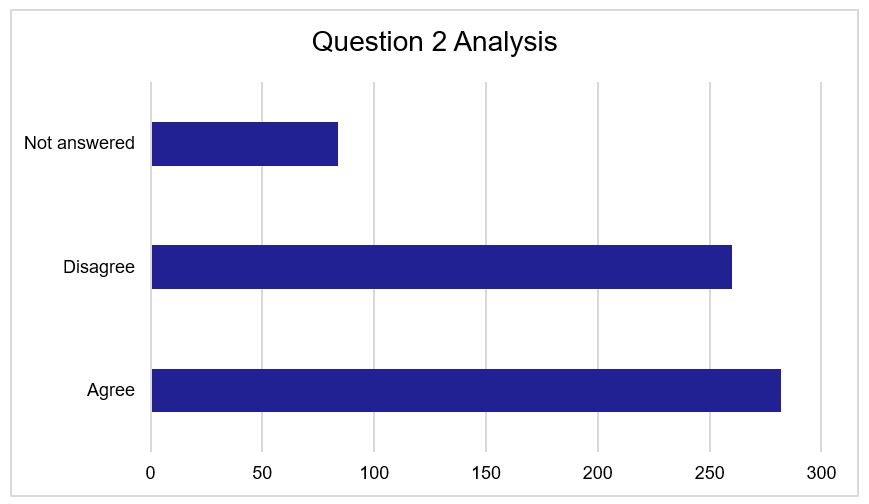
Question 2 Analysis
Of the 408 comments received for question 2, 152 were from respondents who answered agree to question 2 and 245 from those who answered disagree. 11 respondents who left a comment did not answer question 2.
Example comments relating to question 2 are included below:
“Agree” response comments
Individual comments
“Since a TRO is required for something as simple as a loading bay or parking adjustment, a TRO should also be required to allow people to store their cars on the pavement.”
Local authority comments
“The example of the TRO format could be followed but should be streamlined to allow proposed Exemption Orders to be a more efficient process.”
Organisation comments
“The London model has worked well as a deterrence to pavement parking but I don't trust non-metropolitan LA's to follow the spirit of the London exemptions.”
“Disagree” response comments
Individual comments
“This is more unnecessary work and cost for local government and should not be promoted.”
Local authority comments
“This process would benefit from being stream lined and simplified from the existing Traffic Regulation Order process.
The new Experimental Traffic Regulation Order process would be a more suitable example, or via notice.”
Organisation comments
“We are concerned that following the TRO format may lead to delays where access is needed on roads where larger vehicles (such as emergency vehicles and refuse collection vehicles) might not be able to get through.
We would encourage a more streamlined approach, where local authorities may be able to enact emergency procedures where access for emergency vehicles is proving to be a potentially dangerous problem.”
Question 3
Are there any additional points you feel should be shown in a Pavement Parking Exemption Order?
347 comments were received for question 3.
Example comments relating to question 3 are included below:
Individual comments
1. “Street furniture needs to be addressed - shopkeepers give little thought to users of the pavement, especially people with sight loss. Most temporary, moveable street furniture is totally dispensable.”
2. “There should be a consideration of the likely repair and maintenance cost of upkeep of the footway due to the weight of parked vehicles, and this should be clearly presented as part of any proposed exemption order. Perhaps local residents or businesses particularly lobbying for the exemption can be given the opportunity to fund such an increase in costs via their business rates / council tax being adjusted.”
Local authority comments
1. “Perhaps include a statement of reasons for future reference/guidance on why the exemption was promoted in the first place.”
2. “Just to make the process of implementing and amending these orders as simple as possible.
These orders should be as simple as possible for the members of the public to understand.”
Organisation comments
1. “Exemption should only be made when it can be demonstrated that no pedestrian or legitimate footway user will be inconvenienced or suffer additional risk.
As footway surfaces are not designed to bear the loads which vehicles impose, additional damage will inevitably occur where exemptions are allowed, so any exemption should include a fully funded enhanced programme of repair and maintenance.
The process should require Councils to abide by the transport hierarchy and provide sound reasoning why exceptions are being made which prioritise private vehicles over pedestrians.”
2. “An equality impact assessment.”
Question 4
Are there any alternative formats you feel would be better suited to this type of Exemption Order?
251 comments were received for question 4.
Example comments relating to question 4 are included below:
Individual comments
1. “Additional pictures and plans would clarify proposals.”
2. “A different approach for old streets and housing as compared to new areas of housing. We can't make our streets wider.”
Local authority comments
1. “ETRO Process or via Notice.”
2. “Would it be possible for EOs to be map based rather than relying on worded descriptions? Possibly by including pavement width to be retained detailed on the map.”
Question 5
Do you agree or disagree that local authorities should have to publish details of their proposals on their website for a period of no less than a week before, and during the consultation response period?
The total number answering this question was 541 with 85 not answering.
368 respondents (59%) answered agree to this question. 173 answered no (28%), with 85 not giving a response (14%).
65% of the 20 local authorities who answered this question answered agree while 35% answered disagree.
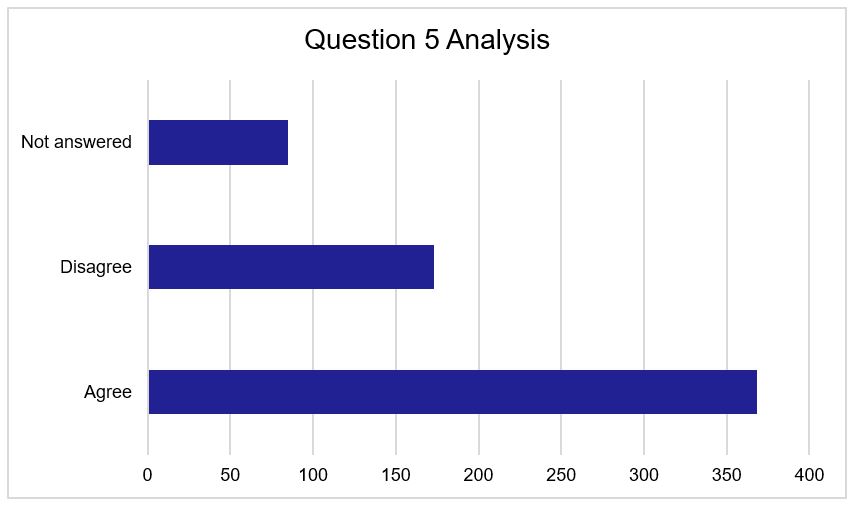
Question 5 Analysis
Of the 352 comments received for question 5, 177 were from respondents who answered agree to question 5 and 167 from those who answered disagree. 8 respondents who left a comment did not answer question 5.
Example comments relating to question 5 are included below:
“Agree” response comments
Individual comments
“It is imperative that non-vehicular users of a footway are given ample opportunity to respond to any consultation.”
Local authority comments
“In addition to the current local press advert and a notice on site Orkney Islands Council currently publish copies of any TTRO or TRO notices on their website, so this makes perfect sense.”
Organisation comments
“We agree that local authorities should have to publish details of their proposals on their website for a period of no less than a week before, and during the consultation response period. Local authorities should publish this information in an accessible, timely and transparent way to ensure local people and communities are aware of their proposals and able to make any necessary representations.”
“Disagree” response comments
Individual comments
“If Scottish Ministers are determined to enable Exemption Orders, then they should be subject to the same long winded, drawn out and technical procedures as TROs and RSOs. Including referral to a Scottish Government Reporter if there are substantive objections that have not been withdrawn.”
Local authority comments
“Disagree, the formal traffic regulation order process should be the avenue used for advertisement. This is unnecessary and places additional resource issues on Local Authorities.”
Organisation comments
“This is unnecessary and would have the effect of raising public awareness but not give them the means to act on it for another week. It's more logical to publish both the proposal and open the consultation at the same time.”
Question 6
Do you agree or disagree that local authorities should keep an archive of all previous and existing notices on their website?
The total number answering this question was 535 with 91 not answering.
452 respondents (72%) answered agree to this question. 83 answered disagree (13%), with 91 not giving a response (15%).
60% of the 20 local authorities who answered this question answered agree while 40% answered disagree.
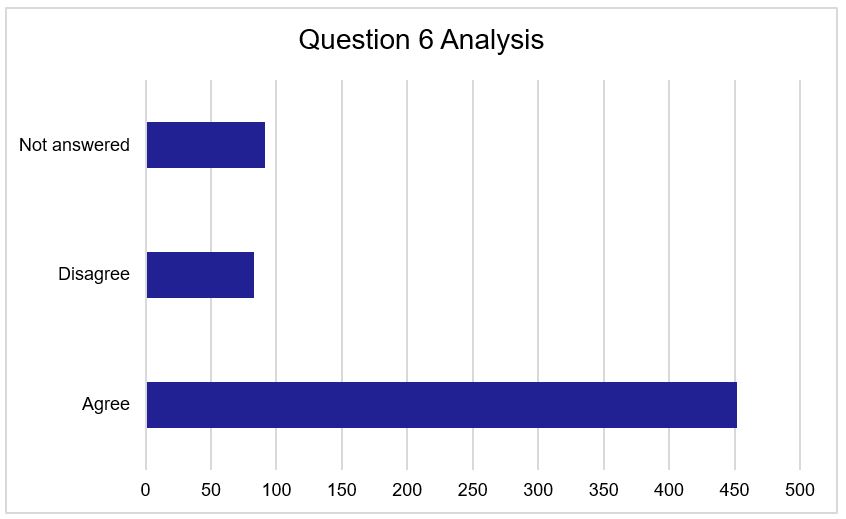
Question 6 Analysis
Of the 264 comments received for question 6, 178 were from respondents who answered agree to question 6 and 77 from those who answered disagree. 9 respondents who left a comment did not answer question 6.
Example comments relating to question 6 are included below
“Agree” response comments
Individual comments
“Unlike planning applications which can be viewed many years after they have been considered, there is not the same visibility of TRO applications. Councils should maintain a publicly searchable database of TRO applications including those for pavement parking exemptions.”
Local authority comments
“Agree but it will be a burden to keep up to date.”
Organisation comments
“From a transparency point of view it makes sense. However, members are mindful that this would be an additional element to this process and that new systems would need to be set up on their websites.”
“Disagree” response comments
Individual comments
“Pedestrian safety must always take priority over traffic flow. Cars should not be on a pavement.”
Local authority comments
“I see the benefit to keeping current notices but why would there be a requirement to retain any that had been revoked? What format would these need to be kept in? Could these be on a map database or would it need to be copies of locations plans and notices/orders.”
Question 7
Do you agree or disagree that local authorities should display the Notice of Order on appropriate locations such as lampposts in the vicinity of a proposed exemption?
The total number answering this question was 535 with 91 not answering.
421 respondents (67%) answered agree to this question. 114 answered disagree (18%), with 91 not giving a response (15%).
85% of the 20 local authorities who answered this question answered agree while 15% answered disagree.
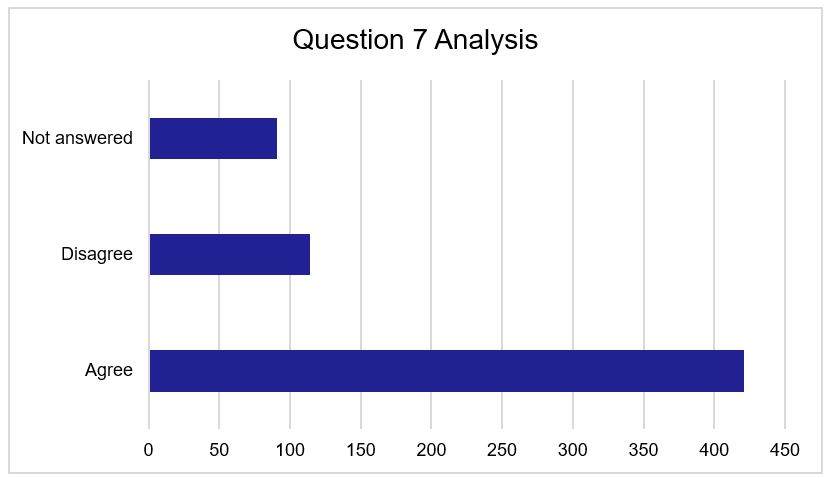
Question 7 Analysis
Of the 296 comments received for question 7, 184 were from respondents who answered agree to question 7 and 105 from those who answered disagree. 7 respondents who left a comment did not answer question 7.
Example comments relating to question 7 are included below
“Agree” response comments
Individual comments
“Visual display is a strong method of presenting proposals to the general public in the specific areas to be affected.”
Local authority comments
“Already done for TRO’s and a useful method of notifying pedestrians, residents and other road users who park in the area.”
Organisation comments
“Agreed, advertisement locally is paramount, again as like planning notices.”
“Disagree” response comments
Individual comments
“Lamppost signs are a waste of time as they are usually too small to be read especially from a car passing therefore miss the most interested parties.”
Local authority comments
“While these notices are of limited useful or the public without internet access, the placement of these is labour intensive in printing and erection/maintaining.
Preference would be for minimal notice requirements while still maintaining notices in the press/website.”
Question 8
Do you agree or disagree with the proposal that there should be no requirement to advertise Notices of Pavement Parking Exemption Orders in the printed press?
The total number answering this question was 523 with 103 not answering.
220 respondents (35%) answered agree to this question. 303 answered disagree (48%), with 103 not giving a response (16%).
90% of the 20 local authorities who answered this question answered agree while 10% answered disagree.
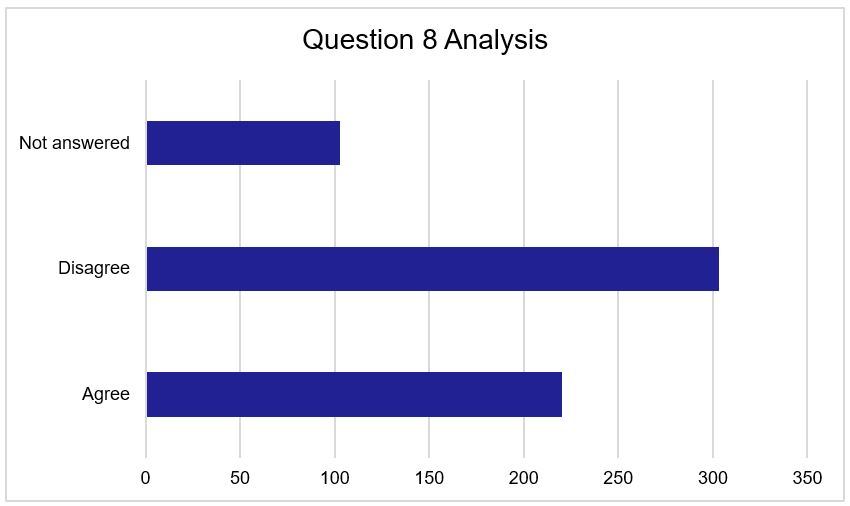
Question 8 Analysis
Of the 346 comments received for question 8, 123 were from respondents who answered agree to question 8 and 211 from those who answered disagree. 12 respondents who left a comment did not answer question 8.
Example comments relating to question 8 are included below:
“Agree” response comments
Individual comments
“Few people read newspapers now. The position would be different if restrictions were being increased; this should be advertised so everyone negatively impacted can object. There are only benefits to making exemption orders.”
Local authority comments
“We do agree, however, more elderly people do still read the paper as their primary source of news and may be housebound. We prefer street notices, but it may be an alternative to street notices for some authorities.”
Organisation comments
“Members unanimously agreed that this should simply be an option and not a requirement.”
“Disagree” response comments
Individual comments
“If it will be expensive to cover the advertising costs, that implies the expectation that local authorities are going to be bombarded with applications. It's therefore even more important that any requested exemptions are properly advertised, so we have a designation in reality and not just in principle if it can be overcome by applicants so easily because nobody knows they are underway.”
Local authority comments
“Disagree, older generation, who are often the ones affected by pavement parking, rely on local papers.”
Organisation comments
“Not everyone has access to the Internet, and those that do not, such as older people, may be the most affected by pavement parking.”
Question 9
Do you agree or disagree with the proposal that the same list of consultees for TROs should be applied to the Exemption Orders process, including Police Scotland and the other parties set out above?
The total number answering this question was 512 with 114 not answering.
340 respondents (54%) answered yes to this question. 172 answered no (27%), with 114 not giving a response (18%).
100% of the 20 local authorities who answered this question answered agree.
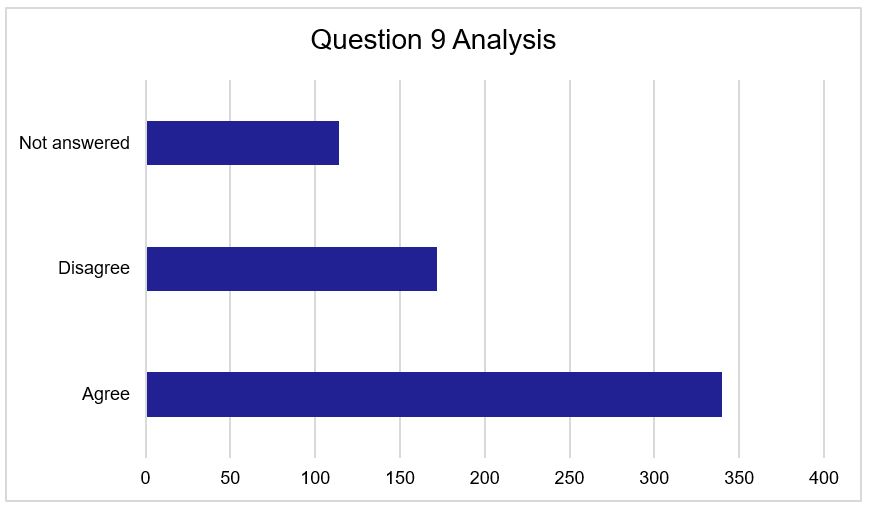
Question 9 Analysis
Of the 264 comments received for question 9, 93 were from respondents who answered agree to question 9 and 159 from those who answered disagree. 12 respondents who left a comment did not answer question 9.
Example comments relating to question 9 are included below:
“Agree” response comments
Individual comments
“I think the procedure should be the same, because this matter has implications for traffic and road safety.”
Local authority comments
“Agree, however as these Exemption Orders are for footways there should be no need to consult with Passenger Transport Authorities.”
Organisation comments
“Local Transport Authorities should be statutory consultees under any future arrangements.”
“Disagree” response comments
Individual comments
“Pedestrian campaign groups and cycle campaign groups must be included on the list of consultees. It isn't fair to only include "motorised transport" groups.”
Organisation comments
“In general terms I do agree with the proposed list of consultees. I would suggest that Community Councils should be added to the list.
I would advocate that a 100m radius for direct consultation. This is because the effect of a parking exemption may influence greater numbers of residents/persons in any residential area within which on-pavement parking is a frequent occurrence. It is assumed that the proposed legislation will markedly influence the capacity of residents and private citizens to park near their homes. The prevention of on-pavement parking will necessitate considerable behavioural changes on the part of local residents.”
Question 10(a)
Do you agree or disagree with the proposal that residencies and businesses, and any other stakeholders present within a set distance of a proposed exemption should have a notice placed through their door or posted to them?
The total number answering this question was 528 with 98 not answering.
417 respondents (67%) answered yes to this question. 111 answered no (18%), with 98 not giving a response (16%).
65% of the 20 local authorities who answered this question answered agree while 35% answered disagree.
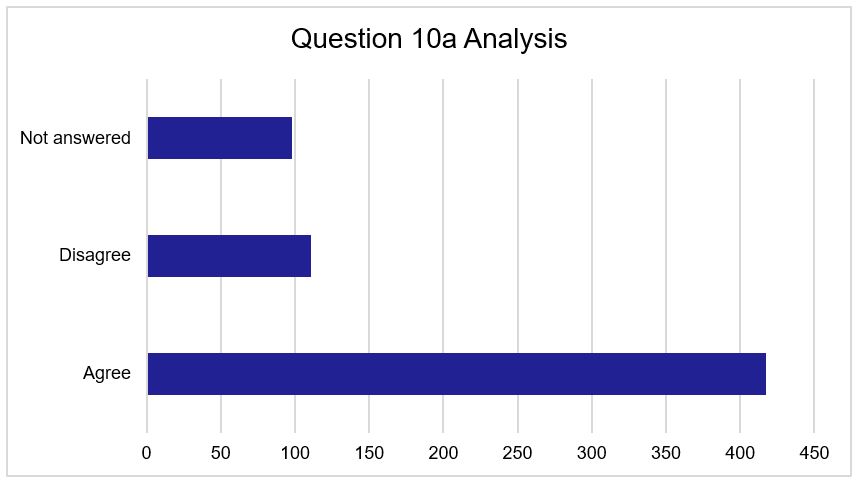
Question 10a Analysis
Of the 253 comments received for question 10a, 143 were from respondents who answered agree to question 10a and 98 from those who answered disagree. 12 respondents who left a comment did not answer question 10a.
Example comments relating to question 10a are included below:
“Agree” response comments
Individual comments
“It is important to ensure those impacted are given sufficient notice in order to make their objections to an exemption known.”
Local authority comments
“With geometry of certain roads etc in some instances the restrictions may alter over the length of the street. It is likely that some residents may have to park out with the frontage of their property and therefore 100m would be a reasonable distance to provide posted information on a notice.”
Organisation comments:
“Provided this is supplementary to other forms of notice.
See also note above on tenants of rented property not advising their landlord of official communications. Often they are left unopened for the landlord to collect at some unknown future date.”
“Disagree” response comments
Individual comments
“50 meters is far too wide an area; only properties directly impacted should be consulted, there is no reason to consult businesses who will only ever face a danger that their customers or employees will have more parking available.”
Local authority comments
“Disagree as its inconsistent with the TRO process. It’s also very onerous on our resources.
If necessary, the minimum letter drop would be on frontagers on the road in question only.”
Organisation comments
“It would be more appropriate for all properties fronting the proposed exemption area to be required to receive a notice rather than specifying an arbitrary distance.”
Question 10(b)
If so, what would you think that minimum set distance should be?
- 100 metres?
- 50 metres?
- 20 metres?
- Something else?
The total number answering this question was 482 with 144 not answering.
216 respondents (35%) answered 100 metres to this question. 75 answered 50 metres (12%), 28 answered 20 metres (4%), 163 answered something else (26%) with 144 (23%) not giving a response.
10% of the 20 local authorities who answered this question answered 100 metres, 25% answered 50 metres, 15% answered 20 metres, 40% answered something else while 10% did not provide an answer.
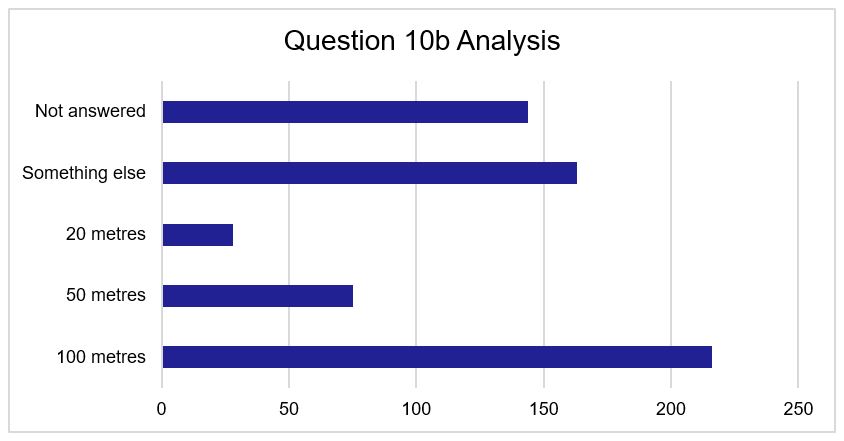
Question 10b Analysis
Of the 301 comments received for question 10b, 83 were from respondents who answered 100 metres to question 10b, 22 from those who answered 50 metres, 10 from those who answered 20 metres and 156 from those who answered something else. 30 respondents who left a comment did not answer question 10b.
Example comments relating to question 10b are included below:
“100 metres” response comments
Individual comments
“The greater the distance, the more you will capture people who walk down the pavement. The narrower the distance, the greater the proportion of people who store their vehicles on the pavement will be.”
Organisation comments
“People other than the immediate neighbours may well be affected and wish to express a view.”
“50 metres” response comments
Individual comments
“If people are going to be displaced from their parking spaces then they need to know if adjoining areas have the same restriction. In residential streets, large areas could be affected meaning they have nowhere to park at all.”
Local authority comments
“Additional notices posted to adjacent streets etc. to be at the discretion of the local authority depending on the circumstances and/or location of an exemption.”
“20 metres” response comments
Individual comments
“People will also see notices on lampposts if staying further away.”
Local authority comments
“In line with planning permissions it should be 20m from the extent of the exemption.”
Organisation comments
“20m is the given distance for neighbour notification and would suit this exemption order.”
“Something else” response comments
Individual comments
“Ideally greater than 100 metres. Anything less than 100 metres ignores the fact that there are other non-vehicle users of the footways who may use the footway for active travel.”
Local authority comments
“Something else – direct frontagers adjacent to the footway where the exemption is to be promoted should receive a posted notice only. Local Authority discretion should be applied out with this area.”
Organisation comments
“Setting a minimum distance is quite arbitrary, it could be a suggestion rather than an instruction that it 'should' happen. Situations will differ widely.”
Question 11
Do you agree or disagree that local authorities should be able to contact other possible stakeholders they may wish to inform who live out with an established contact vicinity?
The total number answering this question was 521 with 105 not answering.
408 respondents (65%) answered agree to this question. 113 answered disagree (18%) with 105 (17%) not giving a response.
95% of the 20 local authorities who answered this question answered agree while 5% answered disagree.
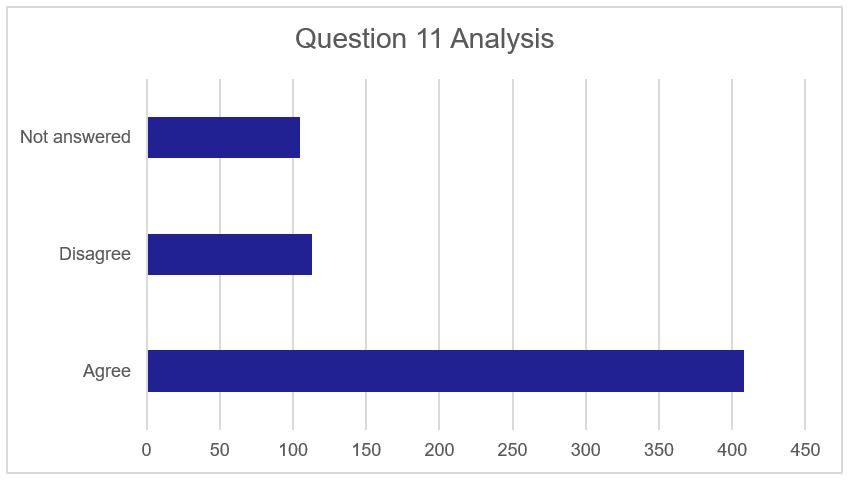
Question 11 Analysis
Of the 244 comments received for question 11, 150 were from respondents who answered agree to question 11 and 83 from those who answered disagree. 11 respondents who left a comment did not answer question 11.
Example comments relating to question 11 are included below:
“Agree” response comments
Individual comments
“Should contact disability organisations, schools, preschool organisations, nurseries, etc within local area - say 1km radius.”
Local authority comments
“If it’s on the route to a community facility, e.g.School, library, doctors, railway station or on a bus route.”
Organisation comments
“We agree that local authorities should be able to contact other possible stakeholders they may wish to inform who live out with an established contact vicinity.
For example, this could include Community Transport operators who are based out with the immediate neighbourhood where the proposed exemption order in question is located, but have users who live there and delivers services within it. Similarly, organisations like the Community Transport Association, as well as national groups representing older or disabled people, could advise and support local authorities to engage with interested local parties.”
“Disagree” response comments
Individual comments
“If e.g. you contact the school, as in your example, this may influence the number of people who wish to park (for work purposes) on a pavement or parents/carers who wish to park on a pavement to pick up/drop off pupils. Their numbers will be greater than residents who may be directly negatively impacted by the exemption.”
Question 12
Are there any other parties who you consider should be formally consulted on a proposed Exemption Order?
312 comments were received for question 12.
Example comments relating to question 12 are included below:
Individual comments:
1. “Yes. Pedestrian campaign groups such as Living Streets. Cycling campaign groups such as Spokes, GoBikeGlasgow, etc. Disability campaign groups. Blind people campaign groups.”
2. “The head teacher and parents council of all schools in the catchment area should be informed. Kids are most affected by pavement parking and it's vital that there is a change to object to parking preventing them accessing there schools in a safe manner.
Also there should be notification to any local active travel groups, community groups, a disability charity, health centres and sport clubs.”
Local authority comments
1. “Yes, Scottish Ambulance Service and Coast Guard as they are as likely to be affected as the fire service.”
2. “Blind association/RNIB and local disability forum and equalities officer.
We feel that blind/partially sighted people or those with mobility issues or a pram are particularly affected by parked vehicles obstructing footways and should be formally consulted on the proposals.”
Organisation comments
1. “Recognised local or national campaign groups such as Cycling UK (Scotland) , Safer Streets, Transform Scotland, and disability representative groups should also be informed so that they have a reasonable opportunity to comment.”
2. “Community councils, where appropriate. Local disabled people's organisations.
Schools within walking distance (where walking distance is the distance where children are not entitled to school transport)”
Question 13
Do you agree or disagree that there should be a required period of time to allow for written notices of support and/or objection to be made (a consultation response period)?
The total number answering this question was 521 with 105 not answering.
439 respondents (70%) answered agree to this question. 82 answered disagree (13%), with 105 not giving a response (17%).
95% of the 20 local authorities who answered this question answered agree while 5% answered disagree.
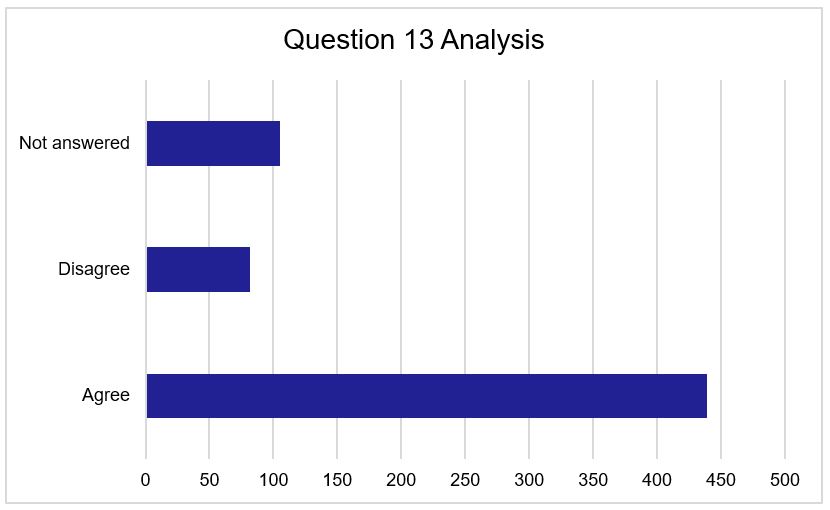
Question 13 Analysis
Of the 203 comments received for question 13, 123 were from respondents who answered agree to question 13 and 69 from those who answered disagree. 11 respondents who left a comment did not answer question 13.
Example comments relating to question 13 are included below:
“Agree” response comments
Individual comments
“The process must be clear and predictable, and must not be arbitrary.”
Local authority comments
“Yes, this keeps the process similar to the current requirements for TROs.”
Organisation comments
“Agreed as per planning applications, this gives community engagement to all.”
“Disagree” response comments
Individual comments
“21 days is not long enough as local organisations often only meet monthly,”
Local authority comments
“The majority of respondents it is presumed would be supportive.”
Question 14
Do you agree or disagree that this period should be for a minimum of 21 days? If no, would you suggest an alternative length of time?
The total number answering this question was 503 with 123 not answering.
339 respondents (54%) answered agree to this question. 164 answered disagree (26%), with 123 not giving a response (20%).
85% of the 20 local authorities who answered this question answered agree while 15% answered disagree.
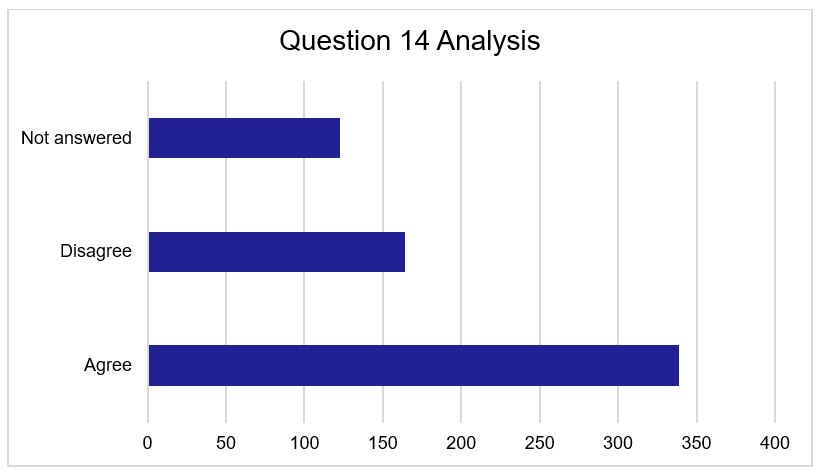
Question 14 Analysis
Of the 238 comments received for question 14, 68 were from respondents who answered agree to question 14 and 155 from those who answered disagree. 15 respondents who left a comment did not answer question 14.
Example comments relating to question 14 are included below:
“Agree” response comments
Individual comments
“Yes. As a disabled parent, it can take me time to sit down and formulate a response. It also gives respondents adequate time to consider their response.”
Local authority comments
“Consistency maintained with familiar procedures avoids potential for confusions and errors.”
Organisation comments
“Agreed with 21 days this is sufficient as per planning applications.”
“Disagree” response comments
Individual comments
“At least a month should be required to allow a monthly check of new applications to always spot any additions.”
Local authority comments
“Disagree. This period should be for 21 days (no maximum or minimum period).”
Organisation comments
“Longer, such as 28 days at least.”
Question 15
Do you agree or disagree that the consideration of notices of support and objections should be handled in a similar way to the existing TRO process?
The total number answering this question was 492 with 134 not answering.
355 respondents (57%) answered agree to this question. 137 answered disagree (22%), with 134 not giving a response (21%).
90% of the 20 local authorities who answered this question answered agree while 10% answered disagree.
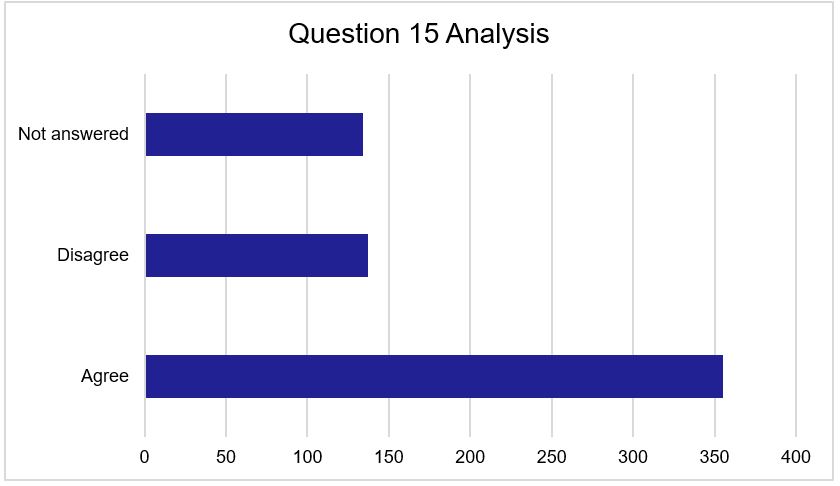
Question 15 Analysis
Of the 200 comments received for question 15, 65 were from respondents who answered agree to question 15 and 121 from those who answered disagree. 14 respondents who left a comment did not answer question 15.
Example comments relating to question 15 are included below:
“Agree” response comments
Individual comments
“A simplified process could keep this beurocracy minimised, otherwise it needs to accommodate all and so the existing process would seem to be acceptable, if it works properly itself.”
Local authority comments
“Agree. However, to streamline the process, objections could be dealt with by a Local Authority delegated officer, rather than Area Committee. Thresholds could also be set for objections, based on the number of objections received, the justification/ robustness of the objection and size/ area of the Exemption Order to rationalise the process.”
Organisation comments
“It should not be left to officials to make the entire decision without the elected members of the council being unable to have a say.”
“Disagree” response comments
Individual comments
“Councils invariably will consider proposals that will align with their general traffic policies. We have a lot of heavy commuting traffic that originates outside our town but continues onwards to Edinburgh. Our councils policy is to support these traffic flows.
Intensive pavement parking in surrounding streets where pavements are routinely completely blocked (outside major schools) are necessary for the uninterrupted flow of unnecessary traffic.”
Local authority comments
“The process should be less formal and possible to execute under delegated powers to Chief Officer or Director level, with consultation of Local Elected Members, without the need for Committee or Council approval.”
Organisation comments
“This would depend on the seriousness that a delay would cause (for example where road access becomes restricted).”
Question 16
Do you agree or disagree that if no objections are received to an Order then it should be processed by the local authority’s roads department without the need to be approved by a committee?
The total number answering this question was 512 with 114 not answering.
217 respondents (35%) answered agree to this question. 295 answered disagree (47%), with 114 not giving a response (18%).
95% of the 20 local authorities who answered this question answered agree while 5% answered disagree.
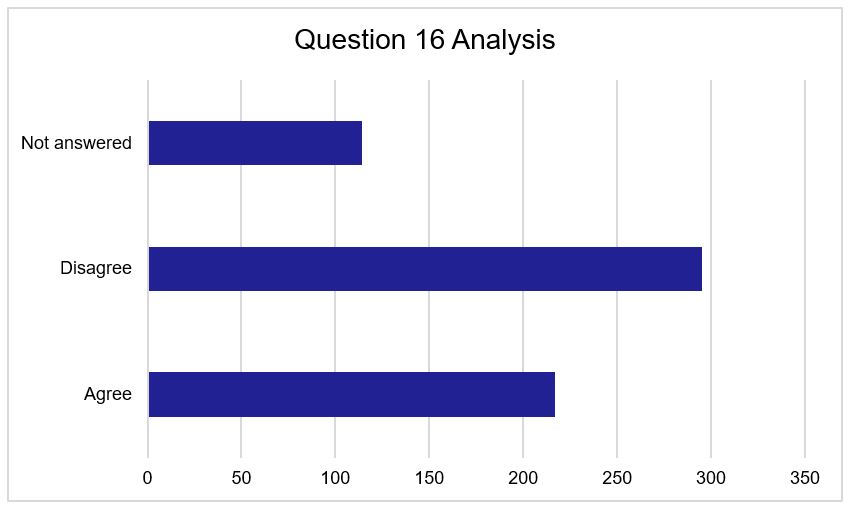
Question 16 Analysis
Of the 286 comments received for question 16, 59 were from respondents who answered agree to question 16 and 220 from those who answered disagree. 7 respondents who left a comment did not answer question 16.
Example comments relating to question 16 are included below:
“Agree” response comments
Individual comments
“If no objections are raised then it would be sensible to proceed.”
Local authority comments
“We already use this process for our normal orders, but we have consulted the local members before the process starts.”
Organisation comments
“Agreed, keeping it simple and productive decision making.”
“Disagree” response comments
Individual comments
“Oversight by committee on all applications regardless of objections would provide consistency, as well as giving the committee context of unopposed applications”
Organisation comments
“There should be local political oversight of decisions that adversely impact pedestrians.”
Question 17
Do you agree or disagree that if there are objections and notices of support then these should be reported to a local authority committee to make a decision, similar to current TROs?
The total number answering this question was 501 with 125 not answering.
399 respondents (64%) answered agree to this question. 102 answered disagree (16%), with 125 not giving a response (20%).
70% of the 20 local authorities who answered this question answered agree while 30% answered disagree.
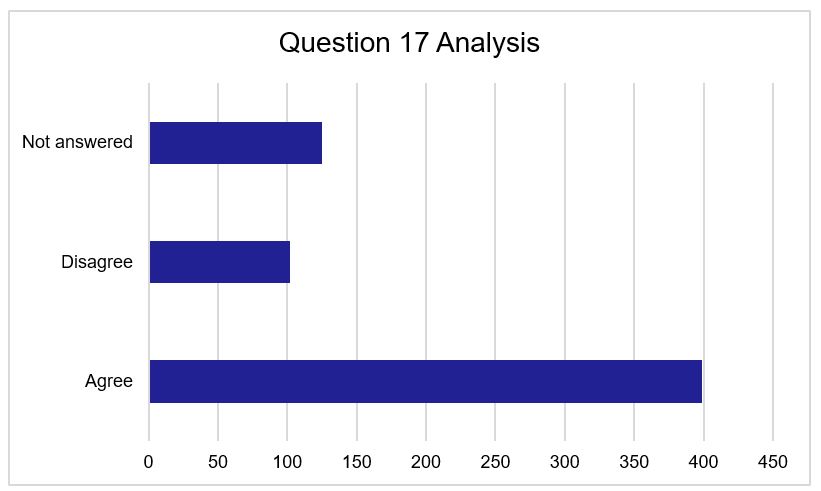
Question 17 Analysis
Of the 112 comments received for question 17, 46 were from respondents who answered agree to question 17 and 64 from those who answered disagree. 2 respondents who left a comment did not answer question 17.
Example comments relating to question 17 are included below:
“Agree” response comments
Individual comments
“Yes, but this process shouldn’t be occurring. It’s adding to council work load, allow councils to spend more time with more money to redesign our streets for people, not to give exemptions to store private property.”
Organisation comments
“It is essential that officers report to local authority if trust is to be maintained.”
“Disagree” response comments
Individual comments
“Local authorities should not have this power. If there are objections to local authority plans, it should go to a third party to make a neutral decision.”
Local authority comments
“Disagree – while this seems reasonable, local authorities should be free to decide how these will be considered under their own Scheme of Governance. There is no need for a national direction on this.”
Question 18
Do you agree or disagree that objectors should be notified as to when the matter will be put in front of committee and given the opportunity to make representations?
The total number answering this question was 507 with 119 not answering.
412 respondents (66%) answered agree to this question. 95 answered disagree (15%), with 119 not giving a response (19%).
50% of the 20 local authorities who answered this question answered agree while 50% answered disagree.
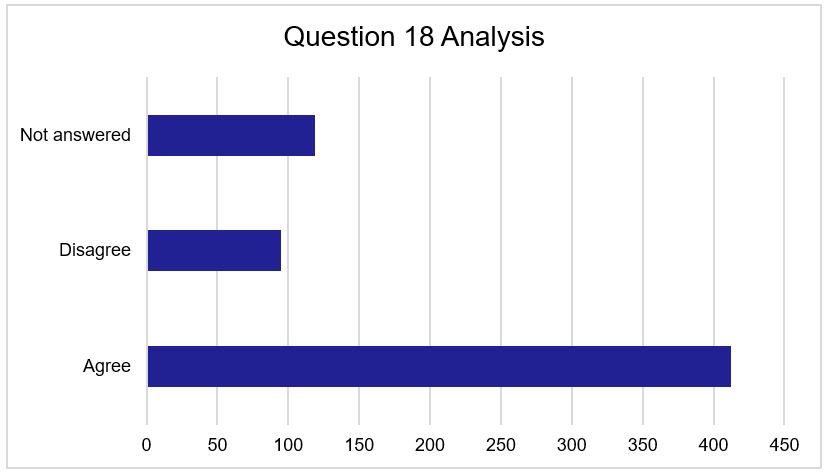
Question 18 Analysis
Of the 188 comments received for question 18, 107 were from respondents who answered agree to question 18 and 71 from those who answered disagree. 10 respondents who left a comment did not answer question 18.
Example comments relating to question 18 are included below
“Agree” response comments
Individual comments
“Objections should carry considerable weight. The onus should not be on objectors to prove their case against pavement parking exemptions.”
Local authority comments
“Yes to notifying, as this is already the case but the decision should be made by committee based on the facts provided by the officers in relation to the need or not for the restrictions, along with the concerns raised by the objectors.”
Organisation comments
“An essential aspect of democratic decisions.”
“Disagree” response comments
Individual comments
“There should not be any exemptions system. Pavement parking should not be permitted in any way.”
Local authority comments
“Disagree – objectors would be able to make written representations during the consultation period. These should be reported in full to the committee making the decision but national direction on whether or not objectors can appear before the committee is unnecessary.”
Organisation comments
“Whether those who have made written objections, can then also appear before the committee or not, should be up to local authorities themselves and not be national direction.”
Question 19
Do you agree or disagree that if a local authority cannot make a decision via committee then they could have the opportunity to refer a case to the DPEA to arrange a Public Local Inquiry or a Hearing?
The total number answering this question was 494 with 132 not answering.
378 respondents (60%) answered agree to this question. 116 answered disagree (19%), with 132 not giving a response (21%).
45% of the 20 local authorities who answered this question answered agree, 45% answered disagree while 10% did not provide a response.
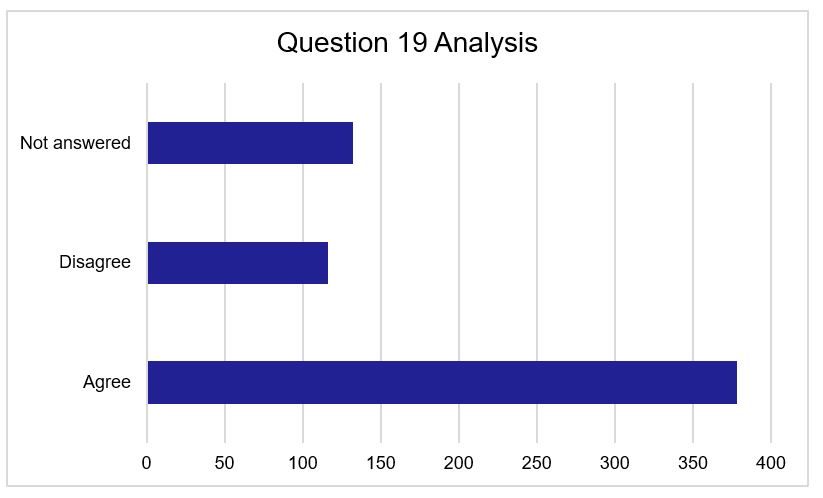
Question 19 Analysis
Of the 172 comments received for question 19, 61 were from respondents who answered agree to question 19 and 98 from those who answered disagree. 13 respondents who left a comment did not answer question 19.
Example comments relating to question 19 are included below:
“Agree” response comments
Individual comments
“Pedestrians are poorer at lobbying councils through organised protests than the business communities who are too powerful in this respect. At public meetings it is more of an open, fairer forum.”
Organisation comments
“Agreed to have an unbiased decision making.”
“Disagree” response comments
Individual comments
“The default state should be the rejection of any proposed Order. If the advocates of such an Order cannot make a compelling case for its approval by a local authority committee, it must be deemed to be a failure.”
Local authority comments
“The local authority needs to make the decision and there should be no reason why they cannot make a decision if the process is followed. Where there may be an issue a temporary order could be used to help resolve the issue.”
Organisation comments
“This would depend on the seriousness that a delay would cause (for example where road access becomes restricted).”
Question 20
Do you agree or disagree that Scottish Ministers should have the opportunity to “call in” a case should a matter of genuine national interest be at stake?
The total number answering this question was 509 with 117 not answering.
364 respondents (58%) answered agree to this question. 145 answered disagree (23%), with 117 not giving a response (19%).
70% of the 20 local authorities who answered this question answered agree, 25% answered disagree while 5% did not provide a response.
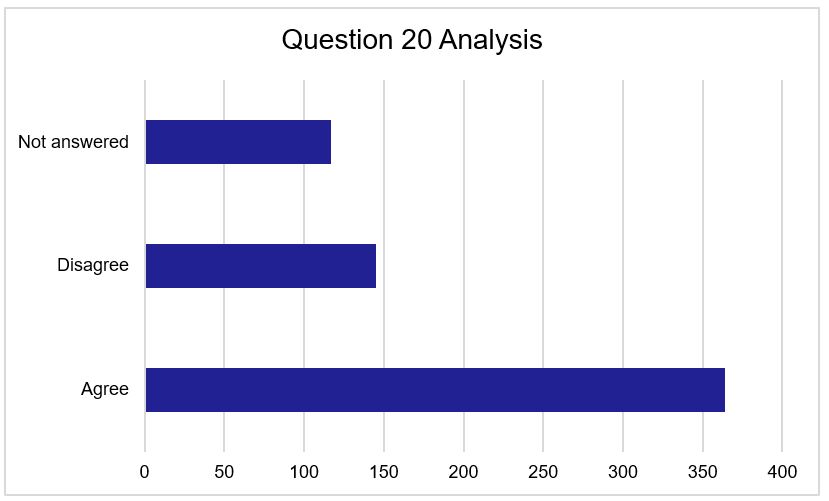
Question 20 Analysis
Of the 207 comments received for question 20, 85 were from respondents who answered agree to question 20 and 112 from those who answered disagree. 10 respondents who left a comment did not answer question 1.
Example comments relating to question 20 are included below:
“Agree” response comments
Individual comments
“The act is an act of parliament and as such ministers must be allowed to intervene when required.”
Local authority comments
“This must be in extreme cases only. It should not be used to undermine local democratic process and should not be a means of councils referring difficult decisions to Scottish Ministers.”
Organisation comments
“BUT this depends on what is defined as the National Interest. There have been some glaring instances where this has been disputed.
If called in, all parties should receive attentions.”
“Disagree” response comments
Individual comments
“Scottish Ministers should not be pressurising local authorities unduly. They should only intervene when the local authority is unable to persuade objectors to withdraw.”
Local authority comments
“It’s difficult to identify what a “national” interest could be in relation to footway parking. It may be of legitimate interest at, for example, transport links, MOD facilities, or on trunk/strategic roads but for local roads, specifically housing estate roads, ultimately it should be left to the roads authority.”
Organisation comments
“This is not necessary and could have the effect of undermining local authorities. Exemption Orders are local not national orders and not of national significance individually. If the intention is to remove any perceived political interventions then this may have the effect of simply escalating political intervention to the next level.”
Question 21
Do you agree or disagree that local authorities should be able to modify their proposals only where the modified Order covers less pavement than the area of exemption in the original order?
The total number answering this question was 492 with 134 not answering.
339 respondents (54%) answered agree to this question. 153 answered disagree (24%), with 134 not giving a response (21%).
85% of the 20 local authorities who answered this question answered agree while 15% answered disagree.
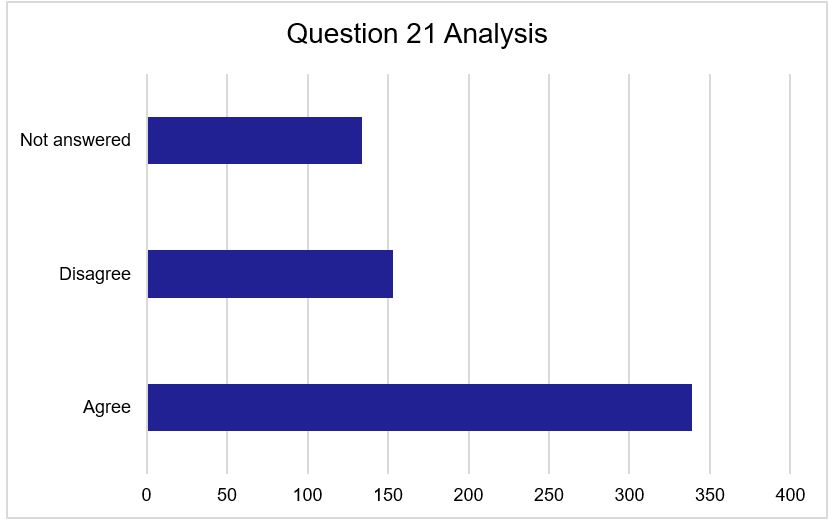
Question 21 Analysis
Of the 187 comments received for question 21, 66 were from respondents who answered agree to question 21 and 107 from those who answered disagree. 14 respondents who left a comment did not answer question 21.
Example comments relating to question 21 are included below:
“Agree” response comments
Individual comments
“I strongly agree with this. It is vital that encroachment on footways may not take place without the full process.”
Local authority comments
“Yes this seems proportional and consistent with current practice.”
Organisation comments
“Agreed to change without compromise. As well as time management and costs not incurred further.”
“Disagree” response comments
Individual comments
“Pedestrian safety must always take priority over traffic flow. Cars should not be on a pavement.”
Local authority comments
“Disagree – if the required minimum width is still available after modification, why the need?”
Question 22
Do you agree or disagree that local authorities should not have to consult on such a modification?
The total number answering this question was 492 with 134 not answering.
267 respondents (43%) answered agree to this question. 225 answered disagree (36%), with 134 not giving a response (21%).
85% of the 20 local authorities who answered this question answered agree while 15% answered disagree.
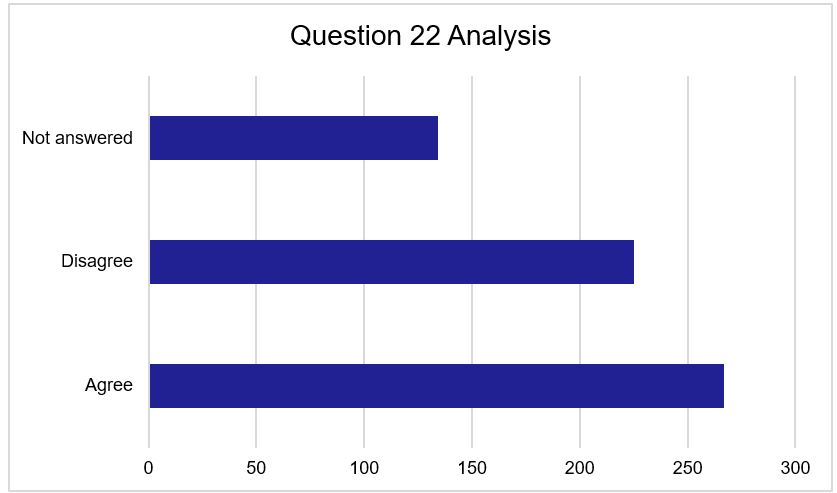
Question 22 Analysis
Of the 197 comments received for question 22, 60 were from respondents who answered agree to question 22 and 120 from those who answered disagree. 17 respondents who left a comment did not answer question 22.
Example comments relating to question 22 are included below:
“Agree” response comments
Individual comments
“Any removal of footway space for the storage of private vehicles, however small, must be subject to the full consultation and approval process.”
Local authority comments
“The modified order would mean a reduced exemption so consultation should not be required.”
Organisation comments
“Agree that the local authorities need not have to consult on reducing the size.”
“Disagree” response comments
Individual comments
“I agree in principal, however the circumstances need careful consideration and reducing the area subject to the order may worsen conditions in the remaining area. It is not clear whether the local authority will enforce maintenance of the minimum 1.5m pavement width for NMUs so this may be further eroded and the pavement become unpassable for vulnerable users if the extent of the order is reduced.”
Local authority comments
“Disagree, as the original process gave scope for supporters to have their say.”
Question 23
Do you agree or disagree that local authorities should not have to advertise the modification except the requirement to place the modified Order on their website?
The total number answering this question was 492 with 134 not answering.
234 respondents (37%) answered agree to this question. 258 answered disagree (41%), with 134 not giving a response (21%).
85% of the 20 local authorities who answered this question answered agree while 15% answered disagree.
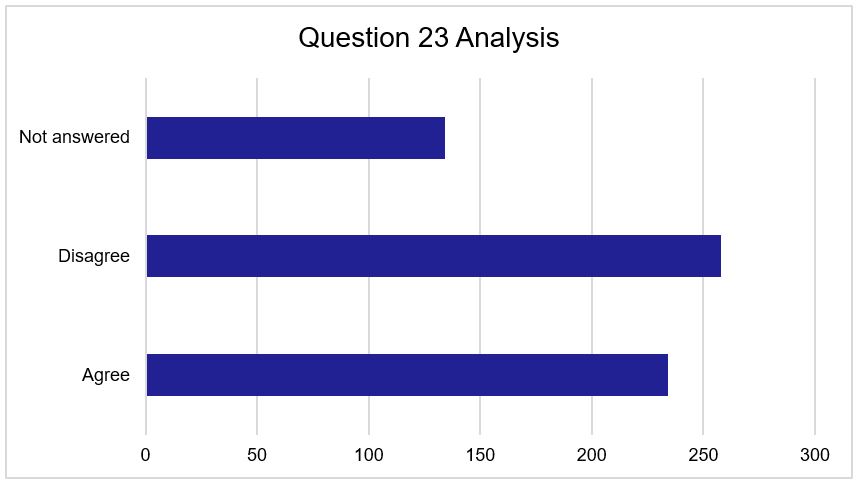
Question 23 Analysis
Of the 208 comments received for question 23, 43 were from respondents who answered agree to question 23 and 154 from those who answered disagree. 11 respondents who left a comment did not answer question 23.
Example comments relating to question 23 are included below:
“Agree” response comments
Individual comments
“Yes. Less pavement occupied by vehicles is good.”
Local authority comments
“Agree, the modification should just involve modifying the original order to suit the change then place on the Local Authorities website once the modification comes into force.”
“Disagree” response comments
Individual comments
“I disagree because this will encourage a practice of proposing an exemption for a larger than necessary area and then modifying to a smaller area after objections are noted. The full process should be restarted with any modification.”
Local authority comments
“Disagree. Publish in the same way as making an order.”
Organisation comments
“If people have been used to parking on the pavement, there will need to be notification that this will change, and not everyone has access to the Internet (or looks at council websites).”
Question 24
Do you agree or disagree with the proposals in relation to notices to be given when making an Order?
The total number answering this question was 466 with 160 not answering.
340 respondents (54%) answered agree to this question. 126 answered disagree (20%), with 160 not giving a response (26%).
70% of the 20 local authorities who answered this question answered agree while 30% answered disagree.
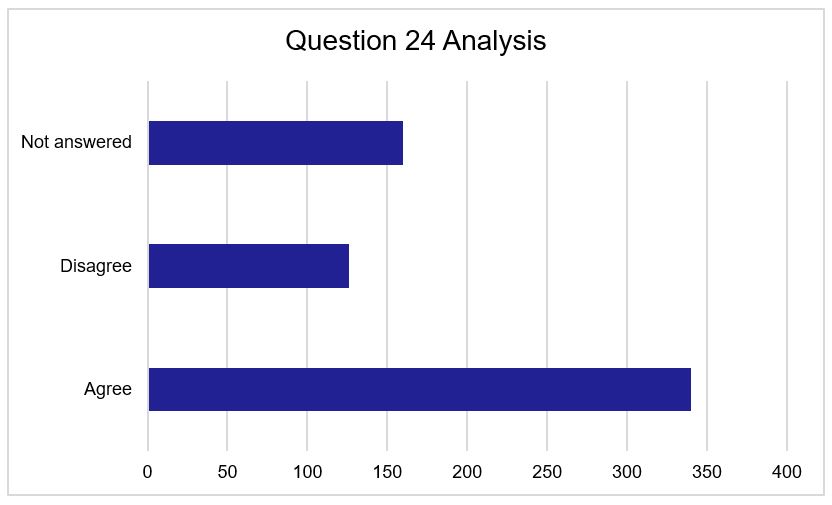
Question 24 Analysis
Of the 171 comments received for question 24, 48 were from respondents who answered agree to question 24 and 108 from those who answered disagree. 15 respondents who left a comment did not answer question 24.
Example comments relating to question 24 are included below:
“Agree” response comments
Individual comments
“There must also be a requirement to erect clear indications that pavement parking is allowed in an area. There must be no scope for confusion by the general public as to whether a piece of pavement can be parked on or not.”
Local authority comments
“Agree with this proposal as it substantially aligns with current TRO procedures.”
“Disagree” response comments
Individual comments
“This should be published in the local press to ensure local awareness of the scope of a proposal to ensure those who use the area to pass through the area as pedestrians or with pushchairs, prams, wheelchairs and shopping trolleys but do not live in the catchment for letters may be alerted to the pavement obstructions planned.”
Local authority comments
“Disagree with the need to write to objectors. They will have had a response to their objection and they can read the committee minutes.
Disagree with the need to post a notice to the list of premises, though local authorities could choose to do so. Residents should note the lining/signing changes on street.”
Organisation comments
“Agree with proposals 1-3.
Proposal 4 is likely to be unnecessary, so could be an option for local authorities if deemed necessary.”
Question 25
Do you agree or disagree with the proposals in relation to notices to be given when amending an Order?
The total number answering this question was 461 with 165 not answering.
344 respondents (55%) answered agree to this question. 117 answered disagree (19%), with 165 not giving a response (26%).
80% of the 20 local authorities who answered this question answered agree while 20% answered disagree.
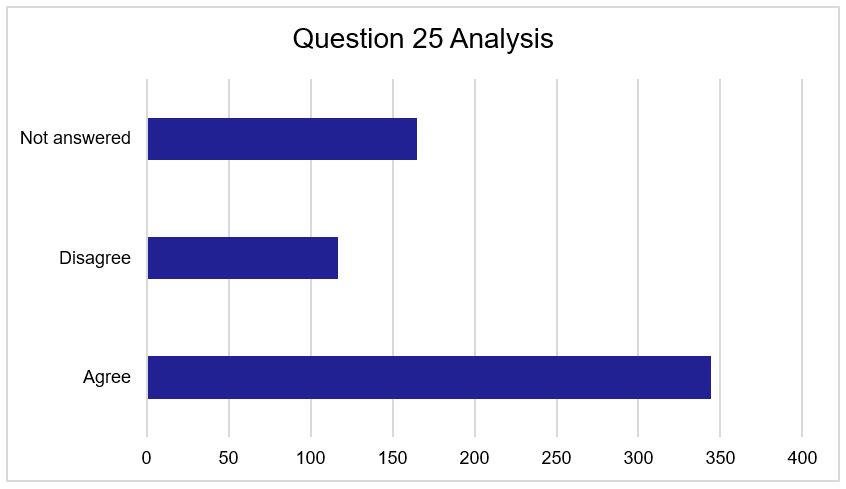
Question 25 Analysis
Of the 151 comments received for question 25, 40 were from respondents who answered agree to question 25 and 93 from those who answered disagree. 18 respondents who left a comment did not answer question 25.
Example comments relating to question 25 are included below:
“Agree” response comments
Individual comments
“Please use a trial period to gauge cause and effect without the extra financial cost of amending an order.”
Local authority comments
“This is consistent with the current order process.”
“Disagree” response comments
Individual comments
“Consultation with community councils and active travel stakeholders should be required.”
Local authority comments
“Disagree – any amendment should go through the full order-making process in line with traffic orders.”
Organisation comments
“Any amendment should go through the full order-making process in line with traffic orders.”
Question 26
Do you agree or disagree with the proposals in relation to notices to be given when revoking an Order?
The total number answering this question was 464 with 162 not answering.
353 respondents (56%) answered agree to this question. 111 answered disagree (18%), with 162 not giving a response (26%).
75% of the 20 local authorities who answered this question answered agree while 25% answered disagree.
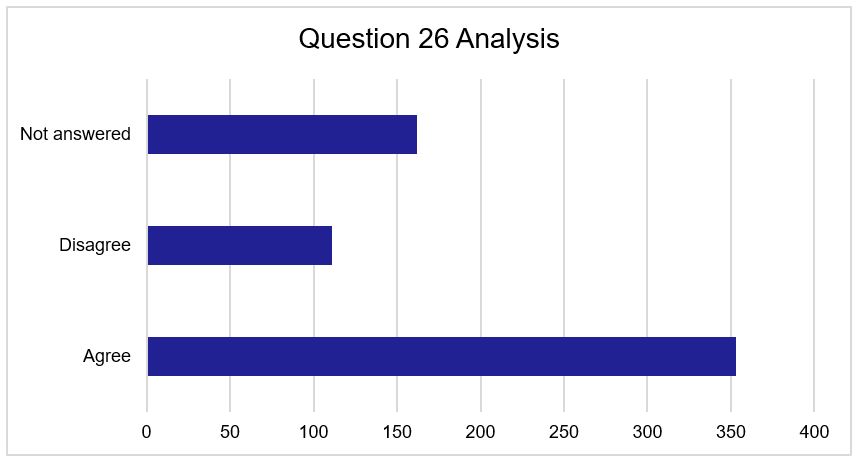
Question 26 Analysis
Of the 149 comments received for question 26, 47 were from respondents who answered agree to question 26 and 87 from those who answered disagree. 15 respondents who left a comment did not answer question 26.
Example comments relating to question 26 are included below:
“Agree” response comments
Individual comments
“A period of 21 days is sufficient to advise vehicle users that pavement parking is no longer permitted. Objections to revocation should not be permitted.”
Local authority comments
“It is clear enough to all that once markings and signing are removed that no exemption exists and pavement parking would be subject to legitimate enforcement.”
Organisation comments
“Re displaying notices in the vicinity.
These should be large enough to attract notice!”
“Disagree” response comments
Individual comments
“I strongly disagree. The right to object is vital. I don't think the seriousness is grasped of removing ability to park if that person has low mobility. This will affect a great many residential streets eg 1930s ex/current LA housing with no of street parking and narrow streets. Many residents disabled or elderly. Rendering some housebound and massively impacting independence. These people MUST be allowed a continuing voice.”
Local authority comments
“Same requirement to consult should apply.”
Organisation comments
“Any revocation should go through the full order-making process in line with the traffic order procedure.”
< Previous | Contents | Next >